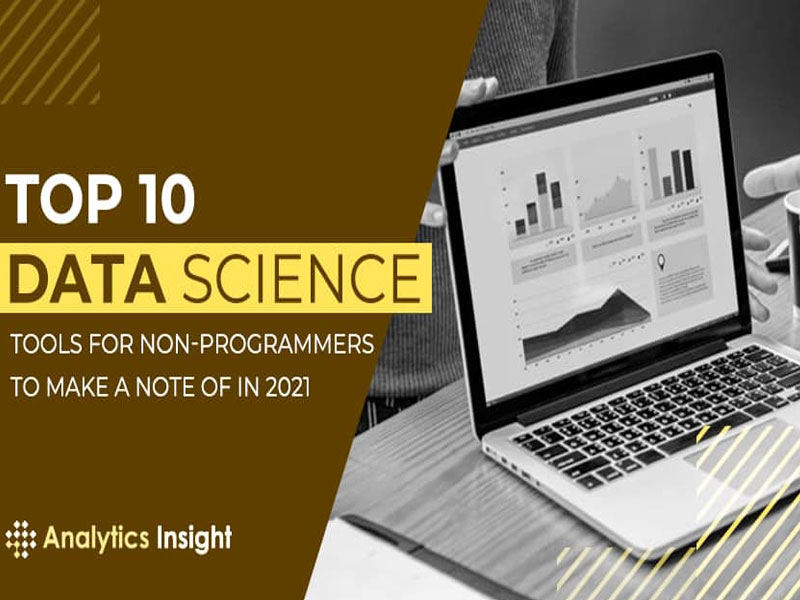Consumer Data Protection: Data Scientists And Data Security
SOURCE: WWW.DISCOVERDATASCIENCE.ORG/
AUG 14, 2023
Top 10 Data Science Tools for Non-programmers to Make a Note of in 2021
SOURCE: ANALYTICSINSIGHT.NET
NOV 22, 2021

Data science has arisen as an advantageous choice for those keen on removing, controlling, and producing experiences from tremendous data volumes. There is a monstrous demand for data scientists across industries, which has pulled numerous non-IT experts and non-programmers to this field. In case you are keen on turning into a data scientist without being a coding ninja, get your hands on data science tools.
You don’t need any programming or coding abilities to work with these tools. These data science tools offer a constructive way for characterizing the whole data science workflow and execute it with next to no coding bugs or blunders.
RapidMiner is a data science tool that offers a coordinated environment for different innovative cycles. This incorporates machine learning, deep learning, data preparation, predictive analysis, and data mining. It permits you to tidy up your data and run it through a wide scope of statistical algorithms. Assume you need to utilize AI rather than conventional data science. All things considered, the auto model will browse a classification algorithms and search through different boundaries until it tracks down the best fit. The objective of the tool is to deliver many models and afterward distinguish the best one.
DataRobot obliges data scientists at all levels and fills in as an AI stage to assist them with building and convey exact prescient models in decreased time. This stage prepares and assesses 1000’s models in R, Python, Spark MLlib, H2O, and other open-source libraries. It utilizes numerous mixes of algorithms, pre-processing steps, elements, changes, and tuning boundaries to convey the best models for your datasets.
Tableau is a top-rated data visualization tool that allows you to break down raw data into a processable and understandable format. It has some brilliant features, including a drag and drop interface. It facilitates tasks like sorting, comparing, and analyzing, efficiently.
Tableau is also compatible with multiple sources, including MS Excel, SQL Server, and cloud-based data repositories, making it a popular data science tool for non-programmers.
Minitab is a software package used in data analysis. It helps input the statistical data, manipulate that data, identify trends and patterns, and extrapolate answers to the existing problems. It is among the most popular software used by the business of all sizes.
Minitab has a wizard to choose the most appropriate statistical tests. It is an intuitive tool.
Trifacta is regarded as the secret weapon of data scientists. It has an intelligent data preparation stage, fuelled by AI, which speeds up the general data preparation process by around 90%. Trifacta is a free independent programming offering an intuitive GUI for data cleaning and wrangling.
Furthermore, its visual interface surfaces mistakes, exceptions, or missing information with no extra task. Trifacta accepts data as input and assesses an outline with different statistics by section. For each section, it suggests a few changes automatically.
Datawrapper is an open-source web tool that permits the creation of essential interactive diagrams. Datawrapper expects you to stack your CSV dataset to make pie diagrams, line graphs, bar outlines (level and vertical), and guides that can be effortlessly installed onto a site.
Knime or Konstanz Information Miner is a device for monstrous information handling. It is being utilized mostly for the investigation of authoritative big data. It is based on the Eclipse stage and it is incredibly adaptable and amazing.
Features
Watson is an artificial intelligence platform by IBM that will permit you to fuse AI tools into your data, paying little mind to where it is hosted, be it on IBM Cloud, Azure or AWS. It is a data governance integrated platform that serves to effortlessly find, plan, comprehend and utilize the data. You can get and order significant data, like keywords, sentiments, feelings, and semantic jobs, from messages and discussions and conversations.
Features
Google Cloud AutoML is a platform to prepare great custom AI models with negligible exertion and limited machine learning expertise. It permits building prescient models that can out-play out all customary computational models. It Uses basic GUI to prepare, assess, improve, and send models dependent on the accessible data by creating great training data. It consequently constructs and sends best in class AI models on structured data.
BigML eases the most common way of creating machine learning and data science models by giving promptly accessible constructs. These constructs help in the ordering, relapse, and grouping problems. BigML joins a wide scope of machine learning algorithms. It helps assemble a robust model without a lot of human intercession, which allows you to zero in on fundamental tasks for example, improving decision making.
LATEST NEWS
WHAT'S TRENDING


Data Science
5 Imaginative Data Science Projects That Can Make Your Portfolio Stand Out
OCT 05, 2022

SOURCE: WWW.DISCOVERDATASCIENCE.ORG/
AUG 14, 2023
SOURCE: MEDIUM.DATADRIVENINVESTOR.COM
OCT 05, 2022
SOURCE: VENTURESAFRICA.COM
OCT 05, 2022